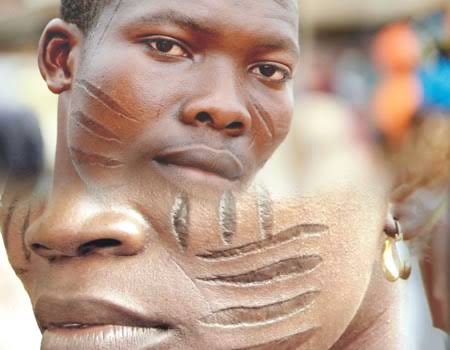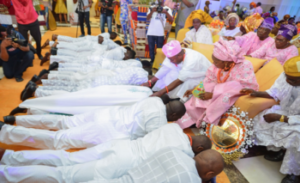

Facial tribal marks: An ancient cultural heritage lost to modernization
By Yekeen Olawale Wakeel
Tribal marks are traditional facial markings or scarifications that were historically used as a form of identification, social stratification, and beauty enhancement to Yoruba heritage. Tribal marks on the cheeks of men and women, young and old, were common among different tribes across the country. The Yorubas in the South-West were not exceptions.
They wore their facial marks that varied from one town, family and lineage to another like badges of honour with pride. Traditionally, tribal marks are made by cutting or scarring the skin with sharp instruments, and the process was often carried out during infancy or early childhood. It is believed that these marks would distinguish members of one family or community from another, helping to foster a sense of identity and belonging.
However, tribal marks were associated with social status and served as a visual indicator of a person’s lineage, heritage, or occupation. They were sometimes considered a symbol of beauty and attractiveness, this perception has however changed over time due to evolving societal norms.
Types of tribal marks are varied; Pele, Gombo (unique to Ogbomosho), Abaja, Oyo, Bamu in Ilorin among others. The tribal marks practice is gradually fading. It has been dealt a heavy blow by civilisation.
Tribal mark can be described as a sign of respect in the olden days, a symbol of identity compared to now, which modernisation has taken over. It is one of the cultural values which portrays Yoruba elegance as “Omoluaabi”(a person of good character).
In Yoruba culture, tribal marks were also considered a form of adornment, enhancing facial beauty and uniqueness. It is believed that tribal marks made them more attractive in those days when many people wished to have them.
It is now seen as a form of stigmatisation, the disappearance of tribal marks has reduced the value of Yoruba culture and heritage which is quite unfair. However, things have changed and tribal marks no longer exist as they used to. It is no longer seen as dignity and respect to one’s culture. It has reduced the Yoruba culture due to modernisation.
It has a rich cultural heritage that includes various traditional practices, and these marks were often specific to different families or lineages within the cultural community and were passed down from one generation to another.
The Nigerian government and various organisations have campaigned against the practice, encouraging communities to abandon it in favour of modern forms of identification and self-expression.
Today, some individuals with tribal marks as a reminder of their cultural heritage, the practice is less common than in previous generations. Many young people in Nigeria now prefer to embrace other aspects of Yoruba culture while foregoing the practice of tribal marking.
Tribal marks were also used as a way to claim a child and indicate their membership within a specific tribe or community. Through tribal marks, the household of the lost person can be traced. It is however portrayed as a sign of identification.
Tribal marks have an enduring history, stretching back thousands of years. For many communities, tribal marks serve as a visual language, telling the story of a person’s place within the group.
This has faced significant challenges. Globalisation, urbanisation, and changing attitudes toward body modification have led to a decline in this ancient tradition. In this sense, the introduction of Western values has led to the stigmatisation of tribal marks, viewing them as ‘uncivilised’ or ‘barbaric.
It is a pity to note that tribal marks practice has been fading away since a federal law banned all forms of child mutilation in 2003. Unfortunately, with westernisation, these marks can only be found on the older generation, and the youths who sported the marks are never regarded as a sign of the enduring spirit of the Yoruba people, instead, they are looked upon with derision and pity.
Some studies have stressed that tribal marks are a significant part of Yoruba culture, used for a wide range of purposes. In the traditional setting, tribal marks serve as a symbol of beauty adding a unique spice to the way a person looks, that is for beautification.
For spiritual or metaphysical purposes, some children in the olden days are called ‘abiku.’ In other words, they can die anytime and return to where they came from.
It is opined that certain spiritual intervention which involves inscribing a tribal mark on the body of the child can prevent them from returning to where they came from.
Whilst modernization has slowly decimated the cultural system of markings and scarification. This age-old tradition has been shoved into the background and has been distinctly outlawed as a form of mutilation.
It has therefore observed that civilisation has hurt the use of tribal marks. Many are therefore ashamed of bearing tribal marks. There is however, the need for concerted efforts by stakeholders in the cultural industry to reawaken the tribal mark culture in the country.
Yekeen Olawale Wakeel, Chief Museum Education Officer, National Museum, Ile-Ife.




